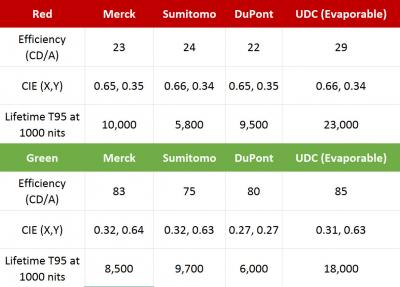A few weeks ago we posted about Merck's soluble OLED material performance, and today we have some more data from the OLED Association. In the table below you can see how Merck's, Sumitomo and DuPont's soluble materials compare to UDC's evaporable OLED's materials.

As you can see, for the red material, evaporable OLEDs have a clear lead in lifetime and efficiency. For the green material that efficiency gap has pretty much closed, while the lifetime of the evaporable materials are still about double than the best soluble materials.
Comments
This is strange indeed. Maybe there's some mistake in one of those reports, or else the older value was at a higher brightness.
Everything @ 1000 nits. But real common brightness is some 200 nits for monitors, so all these times can be multiplied by 5 (roughly, I think). With these lifetimes, they can begin mass production, if costs will be the same as LCD.
-- The coordinate for Dupont Green is incorrect.
-- The aperture in the display is
LGD uses a multistack white. There also most likely use some kind of anti image sticking technology.
There are still various filters between the OLED pixel and the viewer (polarisers and colour filters) Thus even for a properly calibrated TV where each colour is no more than 150 cd/m2 to the viewer, the actual pixel will be driven much brighter. HDR will increase this further. I believe the 2016 LG models can pump out >500 cd/m2 (viewing brightness) - so the pixel driving brightness could even top 1000 cd/m2.
thought sumotomo is using UDC's emitters in combination witheir polymers?
why is The sumitomo red worse than Merck and Green slightly netter?
That depends strongly on the type of technology one is using. For AMOLED you do not require color filters while LG's multi-stack approach does. Not sure about the polarisers...
On the other hand with AMOLED you have a lower fill ratio per area for the individual colors.
Anyhow what one needs to remember:
Candela (the SI unit from which nits are derived) depends on the color of the light. The 200 nits for a display are typically based on white light measurements. 200 nit in green requires a far lower driving voltage while 200 nit in red requires a far higher. Consequently lifetime calculation can get quite complex.
Can the author please provide the references (patent applications or papers) for the table? This would be very helpful. Thank you
I suspect most of these numbers came from presentations at conferences. Patents will go to great lengths to avoid disclosing complete materials sets - only showing the best version of what is being patented - e.g. for an emitter patent, they will often report results using non-optimal or literature-standard hosts and transport layers.


So Have Merck really improved so much from your November 15 update which gave lower efficiencies and lower lifetimes (T90s rather than T95)?